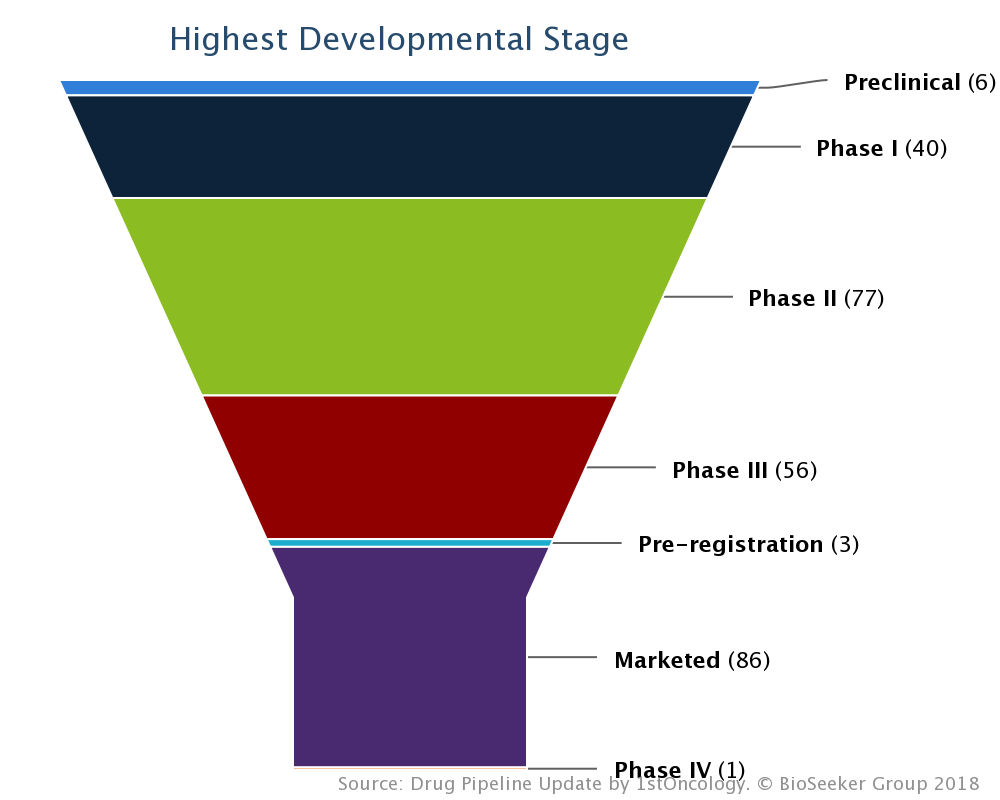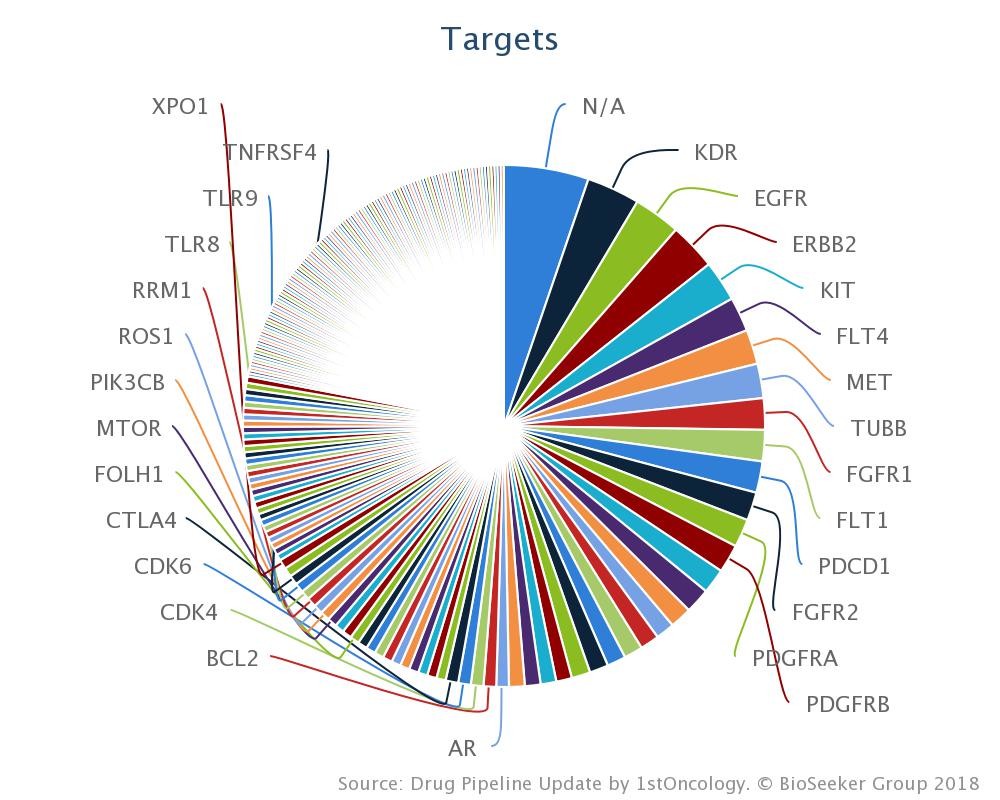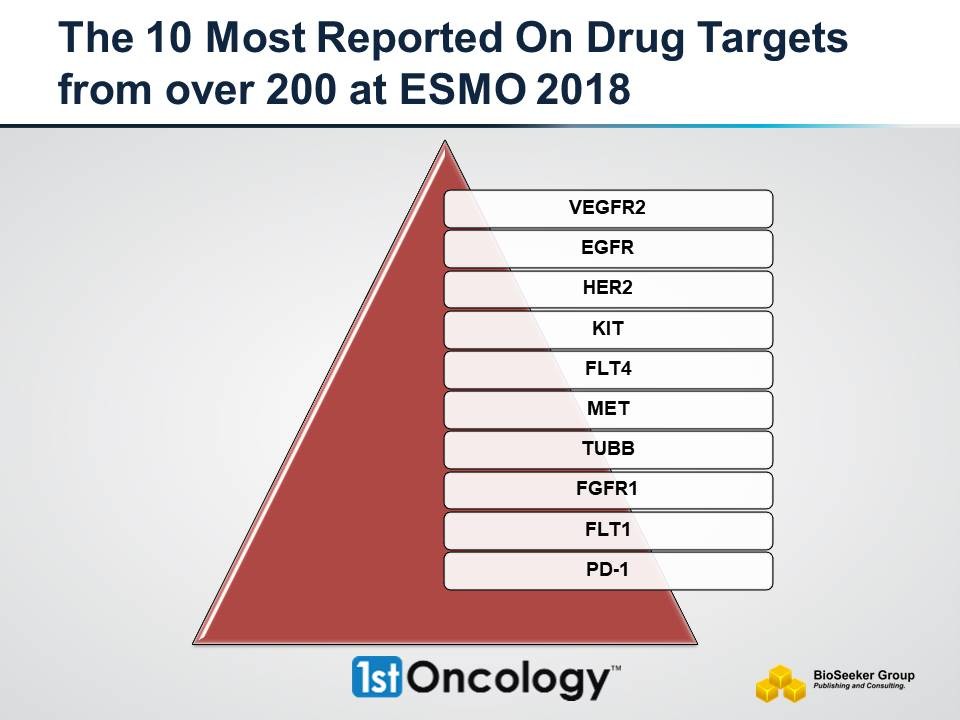On October 19, 2018 Clovis Oncology, Inc. (NASDAQ: CLVS) reported initial data from its ongoing Phase 2 TRITON2 clinical trial of Rubraca at the ESMO (Free ESMO Whitepaper) 2018 Congress (European Society for Medical Oncology) (Press release, Clovis Oncology, OCT 19, 2018, View Source [SID1234529983]). The data show a 44% confirmed objective response rate (ORR) by investigator assessment in 25 RECIST* /PCWG3** response-evaluable patients with a BRCA1/2 alteration. The median duration of response in these patients has not yet been reached. In addition, a 51% confirmed prostate specific antigen (PSA) response rate was observed in 45 PSA response-evaluable patients with a BRCA1/2 alteration.
Schedule your 30 min Free 1stOncology Demo!
Discover why more than 1,500 members use 1stOncology™ to excel in:
Early/Late Stage Pipeline Development - Target Scouting - Clinical Biomarkers - Indication Selection & Expansion - BD&L Contacts - Conference Reports - Combinatorial Drug Settings - Companion Diagnostics - Drug Repositioning - First-in-class Analysis - Competitive Analysis - Deals & Licensing
Schedule Your 30 min Free Demo!
The TRITON2 results were the basis for Breakthrough Therapy designation for Rubraca as a monotherapy treatment of adult patients with BRCA1/2 mutated mCRPC who have received at least one prior androgen receptor (AR)-directed therapy and taxane-based chemotherapy, which was granted on October 2, 2018 by the U.S. Food and Drug Administration (FDA). These data will be highlighted in a poster authored by Dr. Wassim Abida, Medical Oncologist, Memorial Sloan Kettering Cancer Center, and principal investigator for the TRITON2 study. The data have been selected for a poster discussion session that will be led by invited discussant Dr. Joaquin Mateo, of the Prostate Cancer Translational Research Group, Vall d’Hebron Institute of Oncology (VHIO) on 21 October at 09:15-9:40 CEST.
"Rubraca has previously demonstrated antitumor activity in its approved indications for women with advanced ovarian cancer," said Dr. Abida. "These new data show that Rubraca may also offer a new approach for the treatment of mCRPC associated with BRCA1 and BRCA2 alterations, with the potential to achieve a clinical response in patients with few remaining therapy options."
Patients enrolled in the TRITON2 study had received prior treatment with at least one androgen receptor (AR)-directed therapy and taxane-based chemotherapy and were screened for a deleterious germline or somatic alteration in BRCA1, BRCA2 or one of 13 other pre-specified homologous recombination (HR) genes. Study participants were allocated into three cohorts based on the type of gene alteration and disease status, which was determined by genomic sequencing and RECIST criteria, respectively. Each cohort received 600mg Rubraca twice daily and were grouped based on the following criteria: A) alteration in either BRCA1, BRCA2 or ATM genes, with tumors that can be measured with visceral and/or nodal disease; B) alteration in either BRCA1, BRCA2 or ATM genes, with tumors that cannot be measured with visceral and/or nodal disease, or C) alteration in another HR gene associated with sensitivity to PARP inhibition, with or without measurable disease. The primary study endpoints include confirmed ORR per RECIST/PCWG3 in patients with measurable disease at baseline and PSA response in patients with no measurable disease at baseline. Secondary endpoints include overall survival (OS), clinical benefit rate, and safety and tolerability.1
As of the visit cut-off date of June 29, 2018, 85 patients were treated with Rubraca; the overall median treatment duration was 3.7 (range, 0.5–12.9) months and median follow up was 5.7 (range, 2.6–16.4) months. The median treatment duration in patients with a BRCA1/2 alteration was 4.4 months (range, 0.5-12.0 months). Forty-six patients (54.1%) were evaluable for RECIST/PCWG3 response, including 25 patients with a BRCA1/2 alteration. By investigator-assessed RECIST/PCWG3, the confirmed ORR in patients with a BRCA1/2 alteration treated with Rubraca was 44.0% (11/25). Among the 45 evaluable patients with a BRCA1/2 alteration, 51.1% (23/45) had a confirmed PSA response (95% CI, 35.8–66.3).
Overall, the most common treatment-emergent adverse events (TEAEs) of any grade (CTCAE Grade 1-4) in all patients regardless of causality included asthenia/fatigue (44.7%, or 38/85), nausea (42.4%, or 36/85), anemia/decreased hemoglobin (22.4%, or 19/85) and constipation (28.2%, or 24/85). Five patients (5.9%) discontinued therapy due to a non-progression TEAE. One patient died due to disease progression.1
"We are very encouraged by these initial findings from the TRITON2 study, which demonstrate the potential of Rubraca to treat men with advanced prostate cancer whose disease has progressed after receiving multiple prior lines of therapy," said Patrick J. Mahaffy, President and CEO of Clovis Oncology. "PARP inhibitors are now a validated therapeutic class in oncology in multiple tumor types, and these new data underscore the benefit that Rubraca may provide for men with advanced, BRCA-mutant castration-resistant prostate cancer. Having recently received Breakthrough Therapy designation based on these data, we are committed to the rapid development of Rubraca for men with this very difficult-to-treat disease."
The poster discussion session also will include the first presentation of genomic profiling data based on tumor tissue and plasma cfDNA samples from the TRITON clinical program. The poster, authored by Dr. Simon Chowdhury, Consultant Medical Oncologist, Guy’s Hospital & Sarah Cannon Research Institute and co-principal investigator for the TRITON clinical studies, will be included in the same poster discussion session as the TRITON2 data, led by invited discussant Dr. Joaquin Mateo, of the Prostate Cancer Translational Research Group, Vall d’Hebron Institute of Oncology (VHIO). The poster discussion session takes place on 21 October at 09:15-9:40 CEST.
The data suggest cfDNA detected from plasma can be used to identify deleterious HR gene alterations in a manner that is less invasive than tumor tissue testing. Additionally, due to the invasiveness of tumor tissue sample collection, archival primary prostate samples are often used, and data suggest these samples are not representative of the somatic alterations which emerge in mCRPC.
In the study evaluation, patients’ HR gene alteration status was determined by screening a total of 1,311 tumor and 638 plasma specimens, collected from a total of 1,516 patients to determine eligibility for TRITON2 and TRITON3. There was high concordance (74%) in identifying patients with deleterious BRCA1/2 mutations by both tissue and plasma sample. The results demonstrate that detecting genetic alterations within HR genes using cfDNA sequencing could prove to be a convenient method to identify patients who might be suitable candidates for treatment with Rubraca.2 Approximately 12% of men screened for the TRITON2 study were identified as having a BRCA1/2 alteration by plasma screening.
"Tumor tissue testing relies heavily on archival samples taken when a patient is newly diagnosed but may not capture all the alterations that emerge in patients with metastatic disease," said Dr. Chowdhury. "The screening data demonstrate that there is a high concordance between alterations detected in the tissue and plasma assays. Due to the less invasive nature of obtaining cfDNA through plasma testing, this method may be more suitable for both physicians and patients and may also identify more patients eligible for clinical trials of Rubraca."
Clovis’ Rubraca poster presentations will be available online at clovisoncology.com at 07:30 CEST on Saturday, October 20, 2018.
About the TRITON2 Clinical Study
TRITON2 is an international, multicenter, open-label, Phase 2 study of Rubraca in men with metastatic castration-resistant prostate cancer with BRCA gene alterations (inclusive of germline or somatic), which is also enrolling patients with deleterious alterations of other homologous recombination (HR) repair genes, including ATM. The study is currently enrolling across sites worldwide. For more information, please visit www.tritontrials.com.
About Prostate Cancer
The American Cancer Society estimates that more than 164,000 men in the United States will be diagnosed with prostate cancer in 2018,3 and the GLOBOCAN Cancer Fact Sheets estimate that approximately 345,000 men in Europe were diagnosed with prostate cancer in 2012.4 Castration-resistant prostate cancer has a high likelihood of developing metastases. Metastatic castration-resistant prostate cancer, or mCRPC, is an incurable disease, usually associated with poor prognosis. According to the American Cancer Society, the five-year survival rate for mCRPC is approximately 29%.5 Approximately 12% of mCRPC patients have a deleterious mutation in BRCA1 or BRCA2, according to an article published in the Journal of Clinical Oncology Precision Oncology in 2017.6 These molecular markers may be used to select patients for treatment with a PARP inhibitor.
About Rubraca
Rubraca is an oral, small molecule inhibitor of PARP1, PARP2 and PARP3 being developed in multiple tumor types, including ovarian, metastatic castration-resistant prostate, and bladder cancers, as monotherapy, and in combination with other anti-cancer agents. Exploratory studies in other tumor types are also underway. Clovis holds worldwide rights for Rubraca. Rubraca is an unlicensed medical product outside of the U.S. and Europe.
Rubraca EU Authorized Use
Rubraca is licensed for adult patients with platinum sensitive, relapsed or progressive, BRCA mutated (germline and/or somatic), high-grade epithelial ovarian, fallopian tube, or primary peritoneal cancer, who have been treated with two or more prior lines of platinum-based chemotherapy, and who are unable to tolerate further platinum-based chemotherapy.
Click here to access the current Summary of Product Characteristics. Healthcare professionals should report any suspected adverse reactions via their national reporting systems.
Rubraca U.S. FDA Approved Indications and Important Safety Information
Rubraca is indicated as monotherapy for the maintenance treatment of adult patients with recurrent epithelial ovarian, fallopian tube, or primary peritoneal cancer who are in a complete or partial response to platinum-based chemotherapy.
Rubraca is indicated as monotherapy for the treatment of adult patients with deleterious BRCA mutations (germline and/or somatic) associated epithelial ovarian, fallopian tube, or primary peritoneal cancer who have been treated with two or more chemotherapies and selected for therapy based on an FDA-approved companion diagnostic for Rubraca.
Select Important Safety Information
Myelodysplastic Syndrome (MDS)/Acute Myeloid Leukemia (AML) occur uncommonly in patients treated with Rubraca, and are potentially fatal adverse reactions. In approximately 1100 treated patients, MDS/AML occurred in 12 patients (1.1%), including those in long-term follow-up. Of these, five occurred during treatment or during the 28-day safety follow-up (0.5%). The duration of Rubraca treatment prior to the diagnosis of MDS/AML ranged from 1 month to approximately 28 months. The cases were typical of secondary MDS/cancer therapy-related AML; in all cases, patients had received previous platinum-containing regimens and/or other DNA-damaging agents. Do not start Rubraca until patients have recovered from hematological toxicity caused by previous chemotherapy (≤ Grade 1).
Monitor complete blood counts for cytopenia at baseline and monthly thereafter for clinically significant changes during treatment. For prolonged hematological toxicities (> 4 weeks), interrupt Rubraca or reduce dose (see Dosage and Administration [2.2] in full Prescribing Information) and monitor blood counts weekly until recovery. If the levels have not recovered to Grade 1 or less after 4 weeks, or if MDS/AML is suspected, refer the patient to a hematologist for further investigations, including bone marrow analysis and blood sample cytogenetic analysis. If MDS/AML is confirmed, discontinue Rubraca.
Based on its mechanism of action and findings from animal studies, Rubraca can cause fetal harm when administered to a pregnant woman. Apprise pregnant women of the potential risk to a fetus. Advise females of reproductive potential to use effective contraception during treatment and for 6 months following the last dose of Rubraca.
Most common adverse reactions in ARIEL3 (≥ 20%; Grade 1–4) were nausea (76%), fatigue/asthenia (73%), abdominal pain/distention (46%), rash (43%), dysgeusia (40%), anemia (39%), AST/ALT elevation (38%), constipation (37%), vomiting (37%), diarrhea (32%), thrombocytopenia (29%), nasopharyngitis/upper respiratory tract infection (29%), stomatitis (28%), decreased appetite (23%) and neutropenia (20%).
Most common laboratory abnormalities in ARIEL3 (≥ 25%; Grade 1–4) were increase in creatinine (98%), decrease in hemoglobin (88%), increase in cholesterol (84%), increase in alanine aminotransferase (ALT) (73%), increase in aspartate aminotransferase (AST) (61%), decrease in platelets (44%), decrease in leukocytes (44%), decrease in neutrophils (38%), increase in alkaline phosphatase (37%) and decrease in lymphocytes (29%).
Most common adverse reactions in Study 10 and ARIEL2 (≥ 20%; Grade 1–4) were nausea (77%), asthenia/fatigue (77%), vomiting (46%), anemia (44%), constipation (40%), dysgeusia (39%), decreased appetite (39%), diarrhea (34%), abdominal pain (32%), dyspnea (21%) and thrombocytopenia (21%).
Most common laboratory abnormalities in Study 10 and ARIEL2 (≥ 35%; Grade 1–4) were increase in creatinine (92%), increase in alanine aminotransferase (ALT) (74%), increase in aspartate aminotransferase (AST) (73%), decrease in hemoglobin (67%), decrease in lymphocytes (45%), increase in cholesterol (40%), decrease in platelets (39%) and decrease in absolute neutrophil count (35%).
Co-administration of Rubraca can increase the systemic exposure of CYP1A2, CYP3A, CYP2C9, or CYP2C19 substrates, which may increase the risk of toxicities of these drugs. Adjust dosage of CYP1A2, CYP3A, CYP2C9, or CYP2C19 substrates, if clinically indicated. If co-administration with warfarin (a CYP2C9 substrate) cannot be avoided, consider increasing frequency of international normalized ratio (INR) monitoring. Because of the potential for serious adverse reactions in breast-fed children from Rubraca, advise lactating women not to breastfeed during treatment with Rubraca and for 2 weeks after the last dose. You may report side effects to the FDA at 1-800-FDA-1088 or www.fda.gov/medwatch. You may also report side effects to Clovis Oncology, Inc. at 1-844-258-7662.
Click here for full Prescribing Information and additional Important Safety Information.



